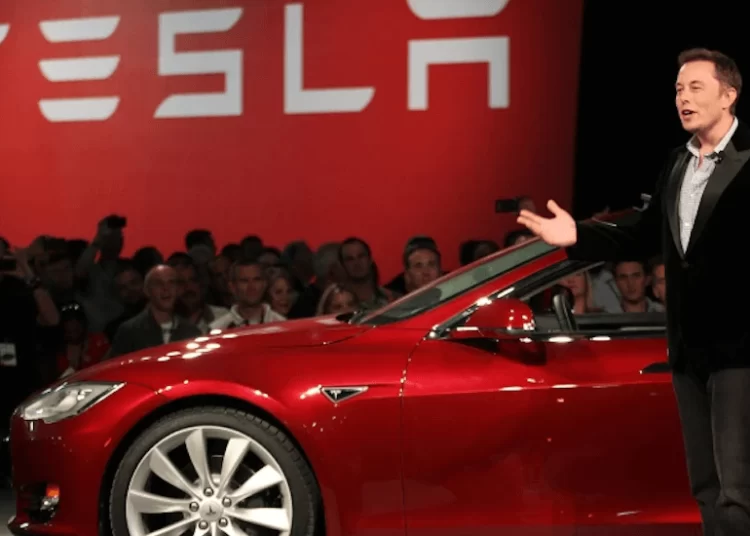Disclaimer: The content of this article, including opinions and data, has been sourced from the public domain. The Executive View does not claim any rights or reservations over the information presented herein. This article is intended for informative purposes only and does not constitute endorsement or verification by The Executive View.
Elon Musk, a visionary entrepreneur and technological genius, embarked on a journey to revolutionize the automotive industry by founding Tesla Inc. in 2003. Armed with an unyielding determination to make electric vehicles (EVs) mainstream, Musk’s relentless pursuit of innovation, cutting-edge technology, and sustainable transportation solutions has catapulted Tesla into the global EV leadership. This success story outlines the remarkable achievements and challenges faced by Musk and Tesla on their path to transforming the automobile landscape and reshaping the world’s perception of electric cars.
The Founding of Tesla
In 2004, Tesla Motors emerged as an ambitious startup with a singular vision to build electric cars that could rival their gasoline-powered counterparts in both performance and aesthetics. Musk, already known for his co-founding role in Zip2 and PayPal, joined Tesla as its lead investor and chairman. The company’s first product, the Tesla Roadster, showcased Musk’s audacious approach as he transformed a Lotus Elise into a high-performance all-electric sports car. The Roadster’s introduction in 2008 shattered the stereotype of EVs being slow and impractical, capturing the imagination of car enthusiasts worldwide.
Challenges and Turning Points
Despite early successes, Tesla encountered several hurdles that threatened its very existence. The financial crisis of 2008 strained the company’s resources, and production challenges plagued the Roadster’s initial manufacturing. However, Musk’s steadfast commitment to his vision enabled Tesla to survive these trying times. He invested personal funds, secured government grants and loans, and elicited support from private investors, ensuring Tesla’s continuity.
In 2012, Tesla released the Model S, a luxury electric sedan that garnered widespread acclaim. The Model S set new standards for EV range, performance, and safety. The introduction of the Supercharger network, a fast-charging infrastructure designed to enable long-distance travel, addressed one of the major concerns associated with electric vehicles. By establishing this charging network, Musk further solidified Tesla’s leadership in the EV market.
Expanding Product Line and Market Penetration
As Tesla’s technology continued to evolve, Musk made a pivotal strategic move in 2015 by announcing the company’s first affordable EV, the Model 3. With a more attainable price point, the Model 3 targeted a broader customer base and aimed to accelerate the transition to sustainable transportation. The Model 3’s launch was highly anticipated, and pre-orders surged to unprecedented levels, showcasing the global demand for EVs and Tesla’s ability to penetrate new markets effectively.
While the demand for Tesla’s EVs soared, the company faced production bottlenecks and logistical challenges with the Model 3. Musk faced immense pressure to meet the massive pre-order demands, but he demonstrated remarkable resilience by streamlining production and implementing innovative manufacturing techniques, such as the Gigafactory concept. The Gigafactories, strategically located around the world, increased production capacity and allowed Tesla to scale efficiently.
Autonomous Driving and Energy Solutions
In parallel to Tesla’s success with EVs, Musk championed the development of autonomous driving technology and renewable energy solutions. The introduction of Autopilot, Tesla’s semi-autonomous driving system, showcased the company’s commitment to revolutionizing the transportation industry. Despite facing scrutiny over the safety and reliability of autonomous technology, Musk remained steadfast in his vision for a self-driving future and continued to invest in research and development.
Furthermore, Tesla expanded its horizons beyond vehicles into renewable energy solutions. In 2015, Tesla unveiled the Powerwall, a home battery storage system that could harness solar energy and provide backup power during outages. This move signaled Tesla’s ambition to transform the energy sector and promote sustainability on a broader scale.
Global Impact and Market Dominance
Tesla’s global impact became evident as it expanded its presence internationally. Musk made strategic decisions to set up manufacturing facilities in Europe and China, recognizing the importance of catering to regional markets and reducing logistical complexities. The Gigafactories in Shanghai and Berlin not only bolstered Tesla’s production capabilities but also showcased its commitment to local communities and sustainability.
By 2021, Tesla had surpassed 1 million electric vehicles on the road, firmly establishing itself as the leader in the EV market. The company’s stock soared, making it one of the most valuable automakers in the world and propelling Musk to become one of the wealthiest individuals globally.
Conclusion
Elon Musk’s relentless pursuit of innovation and commitment to sustainable transportation has been the driving force behind Tesla’s rise to global EV leadership. Through challenges and triumphs, Musk remained undeterred in his mission to transform the automotive industry and the world’s perception of electric vehicles. From the groundbreaking Roadster to the widely adopted Model 3 and beyond, Tesla’s journey exemplifies how visionary leadership and groundbreaking technology can redefine an entire industry.
The success story of Tesla and Elon Musk serves as an inspiration to future generations of entrepreneurs and underscores the importance of perseverance, innovation, and sustainability in building a brighter and cleaner future for all. As Tesla continues to push the boundaries of electric mobility and renewable energy, its impact on the global automotive landscape will undoubtedly be felt for generations to come.









